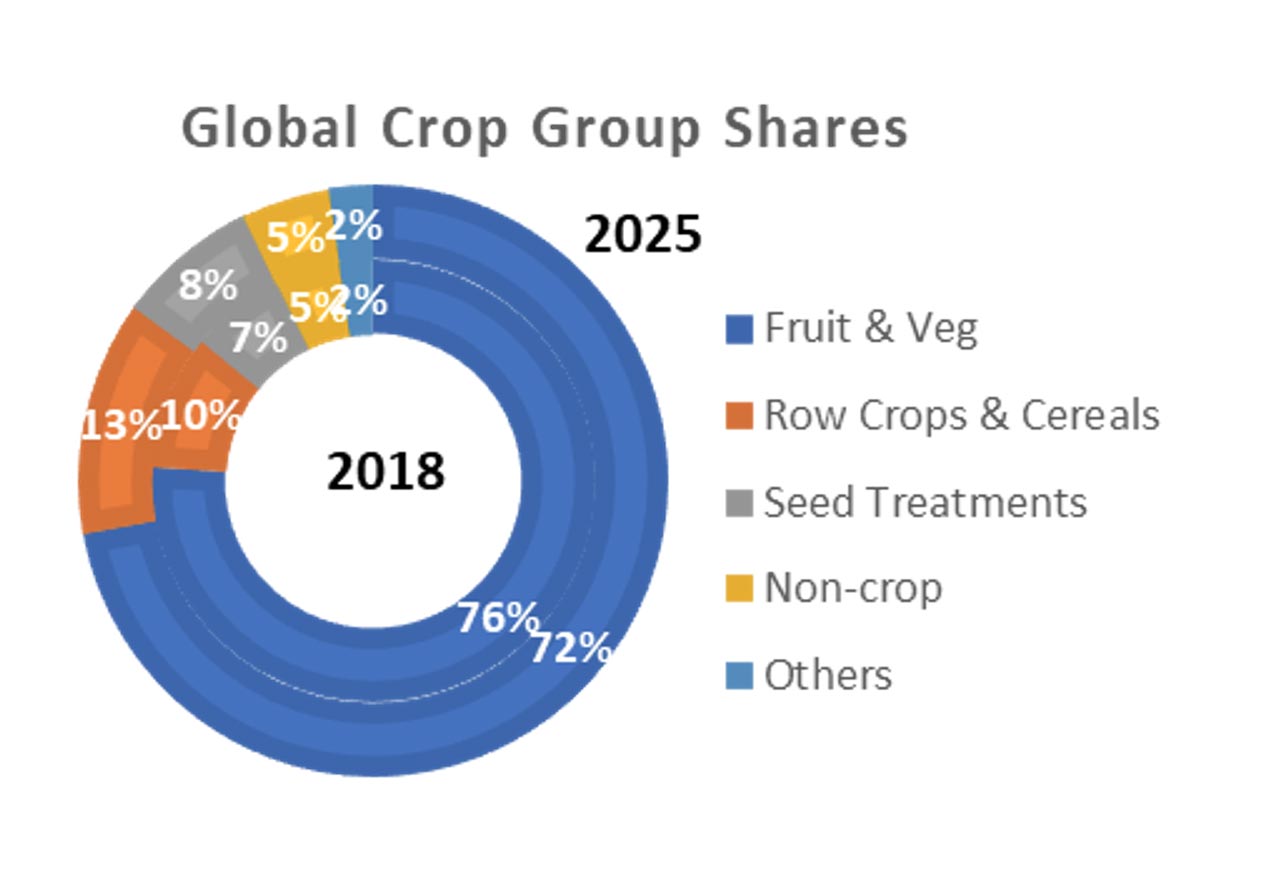Markets For Biological Products: Agriculture
Biocontrols are used in horticulture crops (fruit and vegetables), broad acre or row crops (corn, wheat, soybeans, etc.) and greenhouse production.
Horticulture Crops – Fruits & Vegetables
Biologicals are used more prevalently in fruit and vegetable production than in any other crop group. Global sales of biologicals in the fruit and vegetable segment represent more than 80% of the global market in 2016. A variety of factors lead to the success of biologicals in this crop sector.

As many fruits and vegetables are eaten without processing, consumers are more demanding about how these crops are grown. Pesticide residue concerns are typically much higher for consumers in these crops than in row crops that are not consumed in the raw form. This leads to greater pressure on grocery store chains and food marketers to compete on the basis of effectively managing pesticide residues. As a result, growers seek out products like biologicals that can be used without contributing to pesticide residue concerns.
Managing the development of pest resistance is a bigger concern for fruit and vegetable producers. As many of the pests and diseases require multiple treatments over the course of the season, growers need to avoid relying on products with similar modes of action. Biologicals possess complex modes of action which make them excellent tools to prevent or delay the emergence of resistant populations of pests.
Many fruit and vegetable crops, such as berry crops, annual vegetables, and some tree fruit are harvested multiple times in one growing season as all the fruit and vegetables do not mature at the same time. Combining this with the fact that most of these crops are hand harvested leads to situation where pest control late in the season is challenging. Growers cannot use products with long re-entry periods or pre-harvest intervals without interfering with harvest operations. Biologicals offer growers a solution to this dilemma, based on their inherent safety and short restriction periods on their labels.
And from a performance perspective, incorporating biologicals into a pest management program together with conventional chemical pesticides has often been demonstrated to lead to better efficacy than if chemical pesticides are used exclusively. This means growers can obtain the multiple benefits listed above from biologicals and also see equal or better pest or disease control.
Broad Acre or Row Crops
Biological use in row crops is a small, but rapidly growing segment. Global sales of biologicals in the row crop segment, split between seed treatment and foliar/soil uses, represent between 10% and 15% of the global market in 2016. A variety of factors are driving further adoption of biologicals in row crops.

With increasing cost of seed germplasm, particularly in countries where GMO crops are present, seed treatments are becoming more important to growers as insurance to ensure this investment is protected. Seed treatments that offer protection from soil-borne pathogens and pests and lead to better stand establishment are becoming the norm for most growers. Biological seed treatments have become more common as better formulations with extended storage stability and field performance have been developed by a range of manufacturers.
Foliar and soil uses of biologicals are also gaining acceptance, particularly as growers experience positive results from seed treatments with biologicals. Pesticide residue concerns also can lead growers to choose a biological option.
The main challenge for the foliar use of biologicals in row crops is that that in many cases, row crops are only treated once per growing season for a pest or disease problem. This means the efficacy achieved with a biological must be consistent and dependable. As biological manufacturers have improved production practices and quality control, this challenge is being met successfully, leading to increasing use of biologicals in row crops.
Greenhouse Production
Protected greenhouse production operations are particularly well suited to biologicals. The intensive management of these ornamentals and vegetable crops require multiple applications over extended periods of time to control pests and diseases, making the risk of pest resistance development extremely high. Biologicals are optimal for use in resistance management programs, providing greenhouse growers with effective products that, due to their complex modes of action, are unlikely to lead to pest resistance.
Equally important in greenhouse environments is user and bystander safety. Greenhouse employees spend all day working in the greenhouse, where crop protection products must be applied. In addition, in many cases, customers are also often present in greenhouses in nursery and ornamental operations. These factors cause greenhouse production managers to place a high value on the user safety of biologicals, with short or zero-hour re-entry periods being highly desirable traits.
Many greenhouses also employ predatory insects and mites as part of their insect control programs. It is essential that any product applied to the crop does not harm these beneficials. Biologicals, in general, have a high safety margin for non-target organisms, making them desirable to use in situations where beneficial predators are also being utilized.
While ornamental greenhouse crops are not used for food, these flowers are often brought into your home and displayed in close proximity to family members and pets, which makes the lack of pesticide residue a key benefit of biologicals in this market as well. And of course, where the greenhouse crop is a food crop, like tomatoes or peppers, biologicals do not contribute to undesirable pesticide residues on the harvested product.
